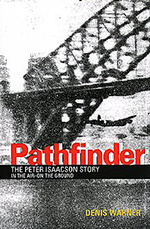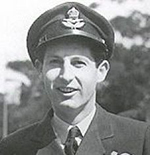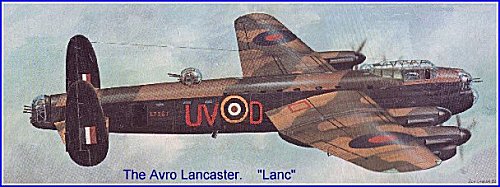
Price: $AU38.85
+ postage
Pathfinder
In The Air – On The Ground
"Pathfinder" is the remarkable story of a young man who defied the odds against survival by flying dangerous missions over Nazi Germany and returned to Australia to a hero's welcome, he and his crew flying Lancaster bomber "Q for Queenie" around Australia to raise funds for the war effort. In one memorably daring "stunt", he flew the huge Lancaster under the Sydney Harbour Bridge.
Isakson's citation read:
"This captain of aircraft has taken part in many successful night attacks, showing a fine offensive spirit and great determination. Sgt Isaacson is an ideal leader who by his courage, skilful pilotage, and cool judgment, holds the complete confidence of his crew. (Their comments were except when landing, when anything was liable to happen).
The crew developed into a crack Pathfinder crew winning every sweep on the 156 P.F.F. squadron for getting the best target results. On completion of their Pathfinder tour, they flew the first Lancaster"Q" Queenie to Australia, where it was flown all around the country supporting the War Bond drives. Isaacson became the first man to fly a bomber "Q" Queenie under the Sydney Harbour Bridge.

Peter Isaacson
Unfortunately on his return to Australia, Isaacson who had been awarded the D.F.M. and subsequently, D.F.C. and A.F.C., and his crew were confronted by open hostility, which seemed to traditionally greet battle seasoned veterans, returning from Europe and the Middle East.
Even though they had much experience it did not seem to be very much utilized to the best advantage nor appreciated in some quarters in Australia. It was obvious to most returning aircrew that a sharp division had developed between the men serving in the European and Middle East zones, and those in the Pacific and Australian zones.
Peter Stuart Isaacson has had two careers – as a war–time pilot, (he was awarded the Distinguished Flying Cross, the Air Force Cross and the Distinguished Flying Medal), and as head of his own publishing empire – and in both lived by the philosophy: "When in doubt, do the courageous thing." Whether as a Pathfinder bomber pilot in World War II, with the lives of his crew dependent on his skill and courage, or as an inspirational and demanding newspaper and magazine boss, "doing the courageous thing" was Peter Isaacson's guiding principle.
In peacetime, the redoubtable Isaacson resumed his fledgling career in journalism and launched his own publishing company on little more than the smell of ink. Isaacson's vision and determination saw his venture grow from one tiny suburban newspaper to a multi–national publishing group. This is a story of a man who succeeded because he insisted on "doing the courageous thing".
Extracts from "Pathfinder" The Peter Isaacson story:
Peter Stuart Isaacson pilot, awarded the Distinguished Flying Cross, the Air Force Cross and the Distinguished Flying Medal
Peter Stuart Isaacson pilot, defied the odds against survival by flying dangerous missions over Nazi Germany and returned to Australia to a hero's welcome, he and his crew flying Lancaster bomber "Q for Queenie" around Australia to raise funds for the war effort. In one memorably daring "stunt", he flew the huge Lancaster under the Sydney Harbour Bridge.
Life as a budding Air Force pilot began to have real meaning when Isaacson was posted to No 27 Operational Unit at Lichfield, Staffordshire. Half a mile walk from the mess across the field covered in mud and slush brought him to his sleeping quarters, huts with no lights. "Who said join the Air Force? conditions are good!" In a short time a move into the stables, closer to the mess, was a welcome relief from trudging in the mud. The new quarters converted stables were more than welcome with decent beds, sheets and pillows. Training at this time consisted of four hours of lectures, the rest of the time was spent , reading , writing, or playing cards.
Following a short leave in London he returned to new quarters at the main station sharing a room with others. It was then down to business of flying Wellington bombers, in bomb dropping exercises and cross country navigation flights, finally a posting to 460 squadron at Breighton where by the end of May 1943 he was ready for action. A raid on Cologne awakened the crew to the dangers. Over the target the bombs had just dropped away from the plane, when sudddenly a cone of searchlights caught them. By twisting and turning in manoeuvres as never been seen before by the Germans, according to his crew members Peter managed to escape but in doing so lost 2,000 feet of height. Again on the return crossing the Dutch coast they were again coned by searchlights but managed to escape unscathed.
Even though English cities had been battered unmercifully by the German onslaught, voices of criticism were raised in England by critics on the bombing of German cities. The answer from Chez Bowyer seemed to sum up the situation quite clearly:
"The real victory belonged to the men who had to prosecute the actual war. To them must be given the ultimate accolade. Strategic or tactical policies may be argued, changed or expounded by the gold braided arm chair warriors, but it is the young aircrew members of the fighters and bombers who had to implement them at the sharp end of the law. Young in years ( any man over 25 years of age was regarded often as an old man by fellow air crews), they nevertheless displayed the courage of veterans as they voluntarily returned to the hell of operations over enemy lands time and time again. Their sacrifices were grievous, the very flower of a whole generation of splendid youth, yet they were never deterred."
Entries in diaries were usually very basic descriptions of a raid. They failed to convey anything of the mental and physical strain on the young aircrews of these operations against Germany. From the moment of take–off till they landed many hours later the crews were in danger. Even friendly fighters and ships off the coast of England, could be, and sometimes were, a threat when they failed to identify the bombers and opened fire. As soon as the aircraft entered enemy territory, they were tracked by the German defences. From this point there was constant danger from anti–aircraft batteries and fighters, abetted by the searchlights, which, in sensitive target areas were numbered by the hundreds.
Air Vice Marshal Don Bennett of Toowoomba, Queensland, creator and commander of the Pathfinder Force, described one single bombing of a target in Germany as the equivalent of going through the Battle of Jutland or any other great naval battle. For the aircrews of Bomber Command, one tour consisted of thirty missions against the enemy, 30 Jutlands.
In July 1942 Joe Grose joined the Isaacson crew in time for a raid on Kassel a distance of just over 500 miles. Inexperienced he had only 26 hours flying time, had never flown at night, had always flown on a straight and level course and had not been trained at an operational training unit. He was totally unprepared for the never ending ducking and weaving by Isaacson to escape the flak and the searchlights. He was being airsick, "Vomiting like a dog", he said, when the Wellington aircraft was attacked by a German fighter over the Zuider Zee. The fighter came in to attack from almost dead astern, opened fire and passed overhead as Peter had dived away to port. The fighter returned to renew the action. This time the fighter holed the Wellington in the port propeller and both main planes. Joe held his fire until the fighter was well in range, and with one of his first bursts in action, Joe, with his machine guns pumped bullets into the JU88. With black smoke pouring from it, the German fighter rolled over and dived toward the ground 13,000 feet away.
Isaacson had completed 22 missions when 460 squadron converted onto Halifaxes, then shortly after converted onto Lancasters. In November, 1942 he was awarded the first of his decorations the Distinguished Flying Medal. January, 1943 Isaacson and his crew having completed their tour of 30 operations volunteered for the Pathfinder Force.
Peter Isaacson was part of the 1st March 1943 Pathfinders raid on Berlin in "Q" for Queenie and heroically guided his crew home to safety despite the damage to the Lancaster.
Unfortunately on his return to Australia, Isaacson who had been awarded the D.F.M. and subsequently, D.F.C. and A.F.C., and his crew were confronted by open hostility, which seemed to traditionally greet battle seasoned veterans, returning from Europe and the Middle East. Even though they had much experience it did not seem to be very much utilized to the best advantage nor appreciated in some quarters in Australia. It was obvious to most returning aircrew that a sharp division had developed between the men serving in the European and Middle East zones, and those in the Pacific and Australian zones.
On 5th October 1943, Lancaster, A66–1 (ED 930), "Q" for Queenie VI took off on the 4th Liberty Loan Tour of Tasmania, Victoria and NSW began. Lancaster ED 930 (A66–1) "Q" for Queenie VI, piloted by Flt. Lt. Peter Isaacson, "beat up" the city of Sydney and flew under the Sydney Harbour Bridge on 22 October 1943 to raise funds for the War Loan. The media claimed "He did it for the £iberty £oan!" The cost of a flight in the Lancaster was £100 per person irrespective of age. The Tour came to an end on 26 October 1943, when a wind shift caused a crash landing of "Q" for Queenie VI at Evans Head in northern New South Wales.

This Lancaster is most unusual as the identification "UV" of 460 squadron was changed to "AR" soon after moving from Breighton early May 1943 and the arrival of the squadron at Binbrook.